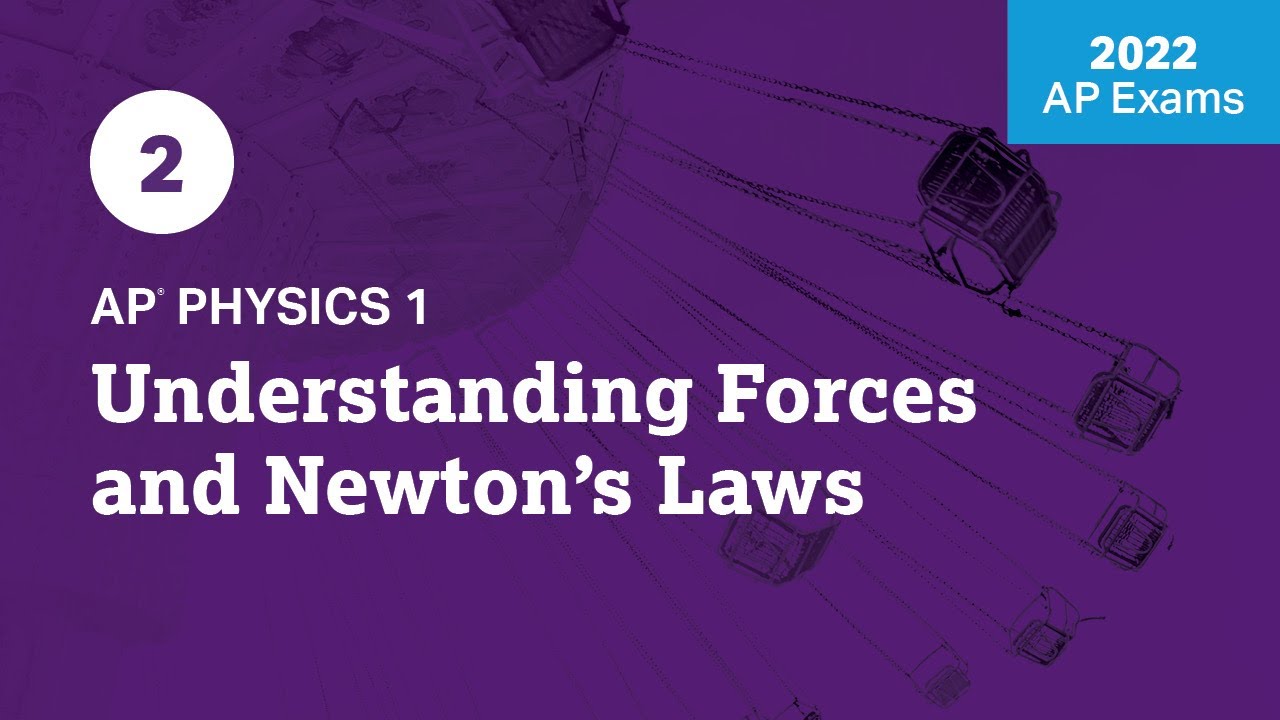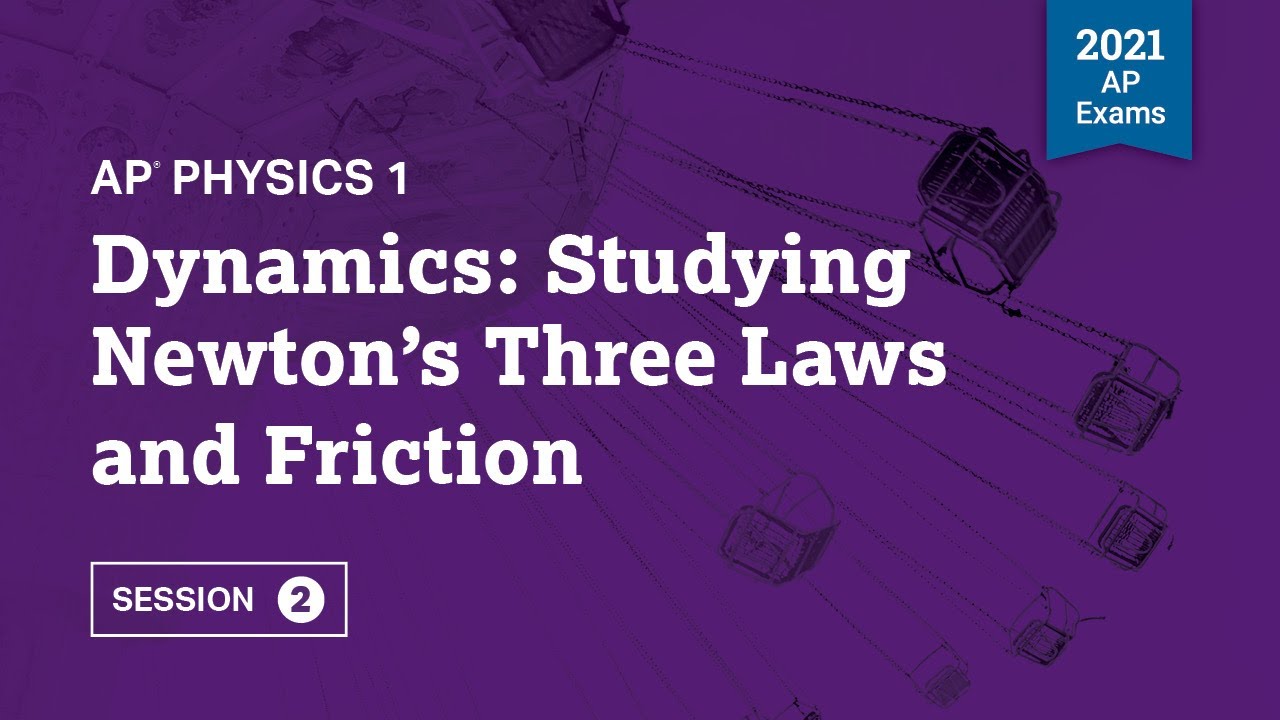AP Physics 1: Dynamics Review (Newton's 3 Laws and Friction)
TLDRIn this educational video, the focus is on dynamics topics for the AP Physics I exam. The script explains the concepts of inertial and gravitational mass, Newton's Three Laws of Motion, and the importance of identifying forces and drawing free body diagrams. It delves into the specifics of forces such as gravity, normal force, friction, and their respective equations. The video also covers the principles of action-reaction forces, the decomposition of gravity on an incline, and the concept of translational equilibrium. The summary is designed to prepare students for the AP exam, emphasizing key points and common mistakes to avoid.
Takeaways
- 📚 Dynamics is the study of motion and the forces causing those motions in objects.
- 🔍 Inertial mass is a measure of an object's resistance to acceleration, whereas gravitational mass is used to determine the force of gravity or weight.
- 🚀 Newton's First Law states that an object at rest will remain at rest, and an object in motion will maintain a constant velocity unless acted upon by a net external force.
- 💨 Newton's Second Law, expressed as net force equals mass times acceleration, shows that acceleration is directly proportional to the net force and inversely proportional to mass.
- 📐 Free body diagrams are essential for analyzing forces acting on an object and should not be broken into components on the initial diagram.
- 🌌 The force of gravity is always directed straight down and is the force that equals the mass of an object times the acceleration due to gravity.
- 🔄 Newton's Third Law states that for every force applied to an object, there is an equal but opposite force applied by another object, forming a Newton's Third Law force pair.
- 📈 Translational equilibrium occurs when an object's net force is zero, indicating the object is either at rest or moving at a constant velocity with zero acceleration.
- 📊 The dimensions of force are in Newtons, which is a unit of force, represented by a kilogram times a meter per second squared.
Q & A
What is the main focus of dynamics in physics?
-Dynamics is the study of the motion of objects and the forces causing those motions.
What is the difference between inertial mass and gravitational mass?
-Inertial mass is a measure of an object's inertia or its resistance to acceleration. Gravitational mass is used to determine the force of gravity or the weight of an object. However, they are experimentally identical, so the difference is not normally identified.
What is Newton's First Law of Motion?
-Newton's First Law states that an object at rest will remain at rest, and an object in motion will maintain a constant velocity unless acted upon by a net external force.
Why is it incorrect to say an object in motion will stay in motion?
-It is incorrect because an object in motion will maintain a constant velocity, which includes both speed and direction. Without a net external force, it will not change its state of motion.
How is Newton's Second Law of Motion typically expressed?
-Newton's Second Law is typically expressed as net force equals mass times acceleration (F = ma), where both force and acceleration are vectors. However, on the AP Physics I equation sheet, it is rearranged to acceleration equals net force divided by mass (a = F/m).
What is the importance of drawing free body diagrams when applying Newton's Second Law?
-Free body diagrams are important because they help identify the object or objects on which forces are being summed and the direction of these forces. They are essential for visualizing and solving problems involving Newton's Second Law.
What are the two common mistakes students make regarding Newton's First Law?
-The two common mistakes are: 1) Saying an object in motion will stay in motion, neglecting the need for a constant velocity, and 2) Forgetting the word 'net' in 'net external force,' which is crucial because it is the sum of all forces that must be zero for an object to remain at rest or maintain constant velocity.
What are the units and base SI dimensions of force?
-The unit of force is the Newton. In base SI dimensions, a Newton is equivalent to a kilogram times a meter per second squared (kg·m/s²).
How is the force of gravity related to the mass of an object and acceleration due to gravity?
-The force of gravity acting on an object, or its weight, is calculated as the mass of the object times the acceleration due to gravity (weight = mass × g).
What are the two types of friction and how do they differ?
-The two types of friction are static friction, which occurs when two surfaces are not sliding relative to each other, and kinetic friction, which occurs when the surfaces do slide against each other. Static friction adjusts to prevent motion up to a maximum value, while kinetic friction is a constant force once motion has started.
What is the relationship between the coefficients of static and kinetic friction?
-The coefficient of static friction is always greater than the coefficient of kinetic friction for two surfaces. This means it is harder to initiate motion than to maintain it.
What is Newton's Third Law of Motion and how is it demonstrated in a free body diagram?
-Newton's Third Law states that for every action, there is an equal and opposite reaction. In a free body diagram, this can be demonstrated by showing an action-reaction force pair, such as the force normal from the wall on the book and the equal but opposite force from the book on the wall.
How are the forces of gravity broken down on an incline?
-On an incline, the force of gravity is broken down into two components: one parallel to the incline (mg sin θ) and one perpendicular to the incline (mg cos θ), where m is mass, g is acceleration due to gravity, and θ is the incline angle.
What is translational equilibrium and what does it imply about an object's motion?
-Translational equilibrium occurs when the net force on an object is zero, which implies that the object's acceleration is zero. This means the object is either at rest or moving at a constant velocity.
Outlines
📚 Dynamics and Newton's Laws of Motion
This paragraph introduces the concept of dynamics, which is the study of motion and the forces causing it. It delves into the distinction between inertial and gravitational mass, with inertial mass being a measure of an object's resistance to acceleration and gravitational mass determining the force of gravity on an object. The discussion then moves to Newton's Three Laws of Motion. Newton's First Law, also known as the law of inertia, states that an object will maintain its state of rest or uniform motion unless acted upon by a net external force. The paragraph also corrects common misconceptions about this law. Newton's Second Law is then explored, explaining the relationship between net force, mass, and acceleration, and emphasizing the importance of free body diagrams in problem-solving. Lastly, the forces acting on a book pushed against a wall are discussed, including gravity, normal force, applied force, and static friction, with a note on not breaking forces into components in initial diagrams.
📐 Forces, Friction, and Newton's Third Law
This section continues the discussion on forces, starting with the definition of force in base SI units, which is a Newton, equivalent to a kilogram-meter per second squared. It explains the direction of the force of friction, which is parallel to the surface and opposes motion, and distinguishes between static and kinetic friction, providing the equations for each. The relationship between the coefficients of static and kinetic friction is highlighted, noting that the coefficient of static friction is always greater, implying it's harder to initiate motion than to maintain it. The paragraph concludes with an explanation of Newton's Third Law, which states that for every action, there is an equal and opposite reaction. This is illustrated with a free body diagram of a book against a wall, showing the normal force and how it pairs with the force from the book on the wall according to Newton's Third Law.
📉 Incline Analysis and Translational Equilibrium
The final paragraph discusses the analysis of forces on an incline, explaining how to break down the force of gravity into components parallel and perpendicular to the incline. It provides formulas for both components, emphasizing that when solving problems, the net force perpendicular to the incline is typically zero, simplifying the solution. The paragraph also introduces the concept of translational equilibrium, where the net force on an object is zero, resulting in the object being either at rest or moving at a constant velocity. The summary concludes with a brief mention of upcoming reviews on work, energy, and power, and an invitation for learners to access more resources on the instructor's website.
Mindmap
Keywords
💡Dynamics
💡Inertial Mass
💡Gravitational Mass
💡Newton's First Law of Motion
💡Net External Force
💡Newton's Second Law
💡Free Body Diagram
💡Force of Gravity
💡Force of Friction
💡Coefficient of Friction
💡Newton's Third Law
💡Translational Equilibrium
Highlights
Dynamics is the study of the motion of objects and the forces causing those motions.
Inertial mass measures an object's resistance to acceleration, while gravitational mass determines the force of gravity on an object.
Newton's First Law states that an object at rest will remain at rest, and an object in motion will maintain a constant velocity unless acted upon by a Net External Force.
Velocity is a vector, implying that an object in motion maintains a constant speed and direction unless a force acts upon it.
Newton's Second Law expresses the relationship between Net Force, mass, and acceleration as vectors.
When applying Newton's Second Law, it's crucial to identify the object, the direction of forces, and to draw free body diagrams.
The force of gravity on an object is always straight down and is calculated as the mass times the acceleration due to gravity.
The force normal is perpendicular to the surface and is always a push, as surfaces can only exert pushing forces.
Force is measured in Newtons, which can be remembered using Newton's Second Law in base SI dimensions.
Frictional force is parallel to the surface, opposes motion, and its direction is independent of the applied force's direction.
There are two types of friction: static friction, where surfaces do not slide, and kinetic friction, where they do.
The force of kinetic friction is equal to the coefficient of kinetic friction times the force normal, while static friction is less than or equal to this product.
The coefficient of static friction is always greater than the coefficient of kinetic friction, indicating it's harder to initiate motion than to maintain it.
Newton's Third Law describes the action-reaction force pair, where every force has an equal and opposite reaction force.
On an incline, the force of gravity is broken into components parallel and perpendicular to the incline for easier problem-solving.
Translational equilibrium occurs when the net force on an object is zero, resulting in zero acceleration and constant velocity or rest.
The review concludes with a mention of upcoming topics on work, energy, and power, and an invitation to access further lectures and notes on the instructor's website.
Transcripts
Browse More Related Video

How to Cram Dynamics in 1.5 hours (AP physics 1)

2022 Live Review 2 | AP Physics 1 | Understanding Forces and Newton’s Laws

AP® Physics 1: Forces and Newton's Laws (Unit 2)

AP Physics 1 - 10 Minute Recap

2021 Live Review 2 | AP Physics 1 | Dynamics: Studying Newton’s Three Laws and Friction

AP Physics Workbook 7.F Rotation
5.0 / 5 (0 votes)
Thanks for rating: